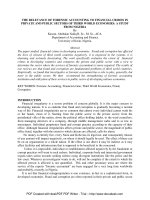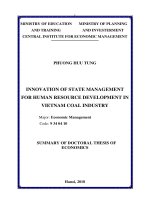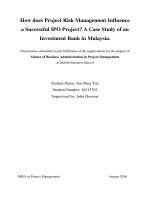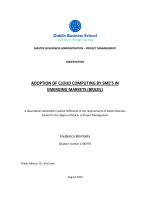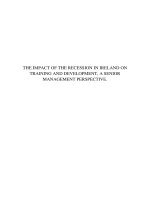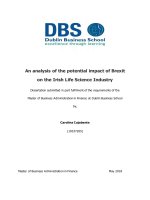Master Thesis in Economics: Incorporation of risk management as a framework for delay mitigation: A study from the Construction project in Nigeria
Bạn đang xem bản rút gọn của tài liệu. Xem và tải ngay bản đầy đủ của tài liệu tại đây (1.02 MB, 132 trang )
In partnership with LJMU
(MBA) Project Management
Dissertation
Supervisor: Paul Taaffe
“Incorporation of risk management as a framework for delay mitigation: A study
from the Construction project in Nigeria”
Written by: Arogundade Abayomi (1641288)
Date: 12-08-2013
Word counts: 20086
1
Table of Contents
List of tables/ illustrations…………………………………………………………...6
Declaration……………………………………………………………………………8
Acknowledgement ……………………………………………………………………9
Abstract…………………………………………………………………………...….10
1
Introduction……………………………………………………………………..11
1.1 Rationale for Topic………………………………………………………....11
1.2 Risk Management in brief…………………………………………..............13
1.3 Need for the present study……………………………………………..........15
1.4 Suitability of the researcher…………………………………………….…..16
2.
3
1.5
Approach to the dissertation…………………………………………….….17
1.6
Recipient for this research………………………………………….……....18
1.7
Scope Limitation…………………………………………………………....18
1.8
Organization of the dissertation……………………………………….……19
Literature Review………………………………………………………….........21
2.1
Project Management……………………………………………………..….21
2.2
Risk Management………………………………………………………...….23
2.3
Delay Mitigation…………………………………………………………......27
2.4
Construction/ Nigeria………………………………………………………...33
Research Methodology……………………………………………………..........41
3.1
Introduction………………………………………………………………….41
3.2
Research Design………………………………………………………...........43
3.2.1 Research Question…………………………………………………….43
3.2.2 Research objectives……………………………………………….......44
3.2.3 Research hypothesis…………………………………………………..44
2
3.3
Structure of research method……………………………………………………...........45
3.4
Research philosophy……………………………………………………...……………45
3.5
Research Approach……………………………………………………………………..47
3.6
Research Strategy………………………………………………………………………48
3.7
Research Choice………………………………………………………………………..49
3.8 Time Horizon………………………………………………………...………….……..50
3.9
Sampling………………………………………………..………………………............51
3.10 Data collection………………………………………..………………………………54
3.11 Data Analysis…………………………………………..……………………………..55
3.12 Plan…………………………………………………………..……………………….56
3.13 Limitation……………………………………………………..………………............57
3.14 Personal bias………………………………………………………..………………...57
3.15 Ethical implication………………………………………………...………………….58
3.16 Time Allocation………………………………………………..……………………..59
4
3.17
Cost……………………………………………………………..……………………59
3.18
Time period Allocate………………………………………………..……………….59
Data Analysis………………………………………………………………..……………...60
4.1
Introduction………………………………………………………..………………...60
4.2
Structure of data Analysis……………………………………………..…………….60
4.3
Age and Demographic section……………………………………….………….…..61
4.4
Findings……………………………………………………………………...............68
4.4.1 Objective 1…………………………………………………………………..…68
4.4.2 Objective 2…………………………………………………………….…..........72
4.4.3 Objective 3……………………………………………………………………...77
4.4.4
4.5
Objective 4…………………………………………………………...................85
Conclusion……………………………………………………………………………92
3
5
Conclusion and Recommendations……………………………...……………….………..93
5.1
Discussion………………………………………………...…………………………..93
5.1.1 Hypothesis 1…………………………………………..………………...............94
5.1.2 Hypothesis 2……………………………………………..……………...............96
6
5.2
General Conclusion…………………………………………..……………………….99
5.3
Recommendations……………………………………………….…………………...100
Personal reflection on own learning and development……………….…………………102
6.1
Reflection on process……………………………………………….………………..102
6.1.1 Information Gathering strategy……………………………….………….…….103
6.1.2 Specific Academic resources…………………………………………………..104
6.2
Reflection on sources…………………………………………………………….…..104
6.2.1 Assumption………………………………………………………….………....106
6.2.2 Selection of resources………………………………………………….….…...106
6.2.3
Lesson learned in finding………………………………………………….….107
6.3
Reflection on dissertation Formulation………………………………………........…107
6.4
Reflection on your learning………………………………………………..................109
6.4.1 Learning Style……………………………………………………………..........109
6.5
Development skill………………………………………………………….................112
6.5.1 Information and communication skills……………………………………...….112
6.5.2 Personal Management skill………………………………………….……..…...112
6.5.3 Cognitive skill…………………………………………………….……….....…113
6.5.4 Interpersonal skill……………………………………………………..………..113
7.
Bibliography…………………………………………………………..…………………..115
7.1
Books……………………………………………………………………..…….…….115
7.2
Journals………………………………………………………………….……….…...118
7.3
Websites…………………………………………………………………….………..125
4
8.
Apendix……………………………………………………………………........................126
8.1
Questionnaire……………………………………………………………….….…....126
5
List of Figures/ illustration
1. Research Onion………………………………………………………………42
2. Time Period Allocate…………………………………………………….......59
3. Gender………………………………………………………….…………….62
4. Age……………………………………………………………….…………..63
5. Nationality………………………………………………………….………..64
6. Job description……………………………………………………….……....65
7. Years of experience…………………………………………….……………67
8. Construction Management……………………………………….………….68
9. Delay Frequency…………………………………………………….………70
10. Delay on Execution………………………………………………….………71
11. Delay on Closure…………………………………………………..………...72
12. Project failure……………………………………………………..…………73
13. Dispute……………………………………………………………..………..75
14. Increase in cost………………………………………………..…………….76
15. Communication barrier…………………………………………..…………78
16. Level of corruption……………………………………………..…………...79
17. Contractor competency………………………………………….….……….81
18. Contractor experience to Project………………………………….………...82
19. Stakeholders influence…………………………………………….………..83
20. Scope creep influence…………………………………………….………...85
21. Project awareness…………………………………………………..……….87
22. Knowledge competency………………………………………….…………88
6
23. Level of risk……………………………………………….………….……..90
24. Systematic risk Management…………………………………….….……… 91
25. Research Category………………………………………………….………105
26. Kolb’s learning Styles……………………………………………….……...110
7
Declaration
I hereby declare that no portion of the work referred to in this dissertation has been
submitted in support of an application for another degree or qualification or any other
university or Institution of learning. Furthermore, all the work in this dissertation is
entirely my own, unless if referenced in the text as specific source and included in
bibliography.
Signed: ____Arogundade Abayomi Anthony__________
Date: ______12-08-2013__________
8
Acknowledgements:
As complicated as this thesis was, I was fortuned enough to have some support and
guidance of some very special people, who I cannot but acknowledge.
First and foremost, I would like to appreciate the almighty God, the author and finisher of
this work. He has been with me constantly guarding and helping me to sail smoothly
through this academic period.
I would also like to offer my heartfelt gratitude to my supervisor, Dr. Paul Taaffe, who
has been of great support throughout my thesis. It is only because of his patience,
knowledge, suggestions and directions that I was able to complete this work. I would also
like to thank my lecturers Dr. Alan Graham and Dr. Nicole Gross for their support and
input to this research.
My deepest gratitude goes to my parent, Sir and Lady Arogundade, who supported my
ambition to do my Masters abroad and stood by me all through the program. You didn’t
only walk but left a longtime print in my life. To you I dedicate this work. To my
siblings: Folashade Arogundade, Taiwo Arogundade and Kehinde Arogundade, thank
you guys you kept me going.
I cannot but mention the support of my better half, Opeyemi Ikuseru for her love and
patient, and how she finds me amazing despite my flaws and weakness. To my friends:
Mobolaji Obisesan, Damola Adekanmbi, Tolu Banjoko, Seun Taiwo, Mary Fiona. What
can I really do without you? I cherish all your input. And to my darling sis Christiana
Popoola, thank you for time taken to prove read this work. You are the best.
9
Abstract
Delay is one of the biggest problems construction project faces in Nigeria. Delay can
lead to many negative effects such as project failure, disputes between stakeholders and
also economic instability. Even though various studies have been considered in the
causes and effects of delays in Nigeria, these studies seldom discuss how risk
management could be integrated to lessen the delay in construction projects in Nigeria.
Systematic risk management is expecting the unexpected; it is a tool which helps control
risk in construction projects. The objective of study is to: (1) to determine the impact of
delay in Nigeria (2) to understand the rate of delay in construction project in Nigeria (3)
To find the root event that causes construction delay in Nigeria (4)Discover the level of
effective systematic risk management that is involved in construction project in Nigeria.
In all the 150 structured questionnaires that were sent to three constructions firm, there
was a response rate of 80%. Typical result shows both hypotheses (1) Delay has a great
impact on the massive project failure and hypothesis (2) Systematic risk management
approach could help to mitigate delay in construction project in Nigeria, was tested and
accepted. The study recommended that risk management can help lessen delay in
construction project if applied in a systematic approach.
It is hoped that these findings will guide efforts to enhance the effectiveness of
construction project in Nigeria.
10
Chapter 1 Introduction:
1.1 Rationale for topic
The Nigerian construction industry is fast growing and it continues to occupy an
important position in the Nation’s economy, even though it contributes less than the
manufacturing or other service industries it is also yet to realize its full potentials despite
Nigeria’s deficit in infrastructures.
According to Vetiva (2011) Nigeria’s Construction sector accounts for 1.4% of its GDP
(Gross domestic profit) more important, is the fact that despite the growth seen in the
contribution sector output, (7 year CAGR of 35%) its contribution to total GDP has
remained at abysmally low levels. In 1981, the construction sector accounted for 58% of
Nigeria’s GDP and in the last three decades, Nigeria’s total GDP has raised to
approximately 495 times its size. On the contrary, Construction sector has only grown to
125 times its size in 1981. Notably, the drivers of Nigeria’s GDP over the last three
decades have remained the same.
A major disparagement facing the Nigeria Construction industry is the growing rate of
delay in project delivery, with the increasing trend of delay in construction project, the
impact of delay has lead to the majorities of project failures. Construction delay means a
time slippage either beyond the contract date or beyond the date that the parties have
agreed upon for the delivery of the project. Haseeb et al. (2011) defined Construction
delay as execution later than intended planned, or particular period, or later than specific
time that all the concerned parties agreed for construction project.
11
Delay has an adverse effect impact on the project success in terms of time, cost, and
quality. Many projects experience extensive delays and thereby exceed initial cost
estimates. In addition to impacting the economic feasibility of projects capital baseline,
extensive delays could cause a ground for disputes or lawsuits between owners and
contractors, increased costs, loss of productivity and revenue, and contract termination.
It has been researched and confirmed by numerous researcher that Construction failure is
on the increase in Nigeria based on delay. Delays represent an area of leakages in the
Construction Project. In Nigeria the problem of delays is severe especially when one
considers the present economic condition of the country. Danladi et al. (2012) state that
Delay is one of the major problems in Nigeria construction industry.
According to Kasim et al. (2012) construction delay is a universal evident reality not only
in Nigeria, however all countries are faced with this global fact. A delay occurs in every
construction project and the significant of these delays varies considerably from project
to project. Barry (2011) state that delay is a reality in the construction process in the
United State and throughout the world. Surveys illustrates that construction projects
suffer delay in Libya and the UK but there is more delay in Libya than in the UK. Studies
found that a building project might be delayed by 41 to 46 days in Libya or 34 to 38 days
in the UK, when considering the most critical delay factors (Shehob, 2012)
12
1.2 Risk Management in brief
Risk management is one of the nine knowledge areas propagated by the project
management institute:
Project Integrated Management
Project Scope Management
Project time Management
Project cost Management
Project Quality Management
Project Human resource Management
Project Communication Management
Project risk Management
Project Procurement Management
Project Stakeholder Management
According to PMBOK (2013) Project Risk Management includes the processes of
conducting risk management planning, identification, analysis, response planning, and
controlling risk on a project. Risk is involved in every business, and the construction
industry is no exception, due to the dynamic nature of construction project, it makes its
prone to risk.
Risk is a multi facet concept. In the concept of construction industry, it could be the
likelihood of the occurrence of a definite event/ factor or combination of events/ factors
which occurs during the whole process of construction to the detriment of the project, a
lack of predictability about structure outcome or consequence in a decision or planning
13
situation, the uncertainty association with estimate of outcomes. In addition to the
different definitions of risk, there are various ways of categorizing risk for different
purposes too. Some categorize risks in construction projects broadly into external risks
and internal risks while other classify risk in more detail categories of political risk,
financial risk, market risk, intellectual property risk, social risk, safety risk.
Risk is inherent and difficult to deal with, and this requires a proper management
framework both theoretical and practical meanings. Risk management is a formal and
orderly process of systematically identifying, analyzing and responding to risks
throughout the life cycle of a project to obtain the optimum degree of risk elimination,
mitigation and/ or control. Significant improvements to construction project management
performances may be achieved from adopting the process of risk management.
Construction projects are of different sizes and of different nature, hence the risk
associated with them also varies. Furthermore, risk management in the Construction
project management context is a comprehensive and systematic way of identifying,
analyzing and responding to risks to achieve the project objectives. Construction Projects
can be extremely complex and fraught with uncertainties. Risk and uncertainty can
potentially caused a delay for Construction Projects. Most of the project management
issues that impact a project arises from associated uncertainty
14
1.3 NEED FOR THE PRESENT STUDY
This research is novel and relevant to the extent that though there are a plethora of
Literature and research on Delay in Construction, Risk management in Construction and
entire failure in Construction, yet most of those pass works dwell squarely on the United
State of America, Canada and countries of the European Union, Asian with little or no
mention of Africa, especially western parts of Africa (e.g. Nigeria)
Despite the uniqueness of construction industry to the growth of national economy,
Nigeria still witness a lot of construction project failure due to delay. Mohammed et al.
(2012) stated that “Delay is one of the major problems in Nigeria construction industry”.
Ayodele et al. (2011) also buttress the fact that “delay have knock on effect on the
construction industry and in indeed in the whole economy”. According to kontangora
(1993) as cited by Ayodele et al. (2011) there are about 4000 uncompleted or abandoned
project belonging to the Federal Government of Nigeria with an estimated cost of above
N300 billion which will take 30 years to complete at the present execution capacity of the
Government, also this issues of delay has been left without adequate attention for too
long which is now having a multiplier effect on the construction industry in particular and
the national economy as a whole. Ibironke (2013) also stress that “delay are one of the
biggest problems construction firms face. Seven out of ten projects surveyed in Nigeria
suffered delays in their execution”.
However, with the rapid increasing failure in construction due to delay in Nigeria , this
research becomes necessary so as to have a basis for weighing the causes and impact of
delay in construction project, and importantly to examine how Risk management could
15
be use as a tool to lessen delay in Construction Projects. Very often, Contractors or
Project Managers mistakes a risk assessment or Monte Carlo simulation for risk
management. Risk analysis or risk assessment is just one component of a successful risk
management program for the best returns, risk are not just analyzed at one point in time,
but continually reviewed throughout the project life cycle.
1.4 Suitability of the Researcher and research objectives
The Researcher is an accountant by profession and has worked in an accounting
department of two major construction firms in Nigeria, before proceeding to Dublin
Business School where he is currently pursuing Masters in Project Management (MBA).
The MBA is to enable the researcher acquire the necessary knowledge and relevant skills
relating to Project Management as the researcher intends to continue his career in
Construction Industry.
Having studied Accounting primarily and worked for four years as an accountant, the
researcher has what it takes to engage in this research. This is coupled with the
knowledge and research skills that have been gained from the MBA program as well as
reliable industry contacts already made that will facilitate this study.
The aim of this research is to identify the causes and effects of delay in Construction
projects in Nigeria. The importance of risk management in construction project, and how
it could help lessen the ever increasing delay in construction project. This study will
contribute to the existing store of knowledge. With this motive, research will be
16
conducted among three construction firms to find answers for the following research
question.
“Can the integration of systemic risk management approach help to manage the causes of
delay in Nigeria Construction Project?”
In order to answer the research question further, the researcher came out with the
following research objectives:
1. To understand the rate of delay in construction project in Nigeria
2. To determine the impact of delay in a Construction Project
3. To find the root event that causes construction delay in Nigeria
4. To discover the level of effective systematic risk management that is involved in
construction project in Nigeria.
Hence to facilitate the investigation justifying the research objectives and to answer the
research question, certain assumptions have to be considered initially. So the hypotheses
that need to be proved or disapproved are as follow:
1. Delay has a great impact on the massive project failure in Nigeria
2. Systematic risk management approach could help to mitigate delay in
construction project in Nigeria
1.5
Approach to the dissertation
The objectives derived will be obtained systematically in the research. Firstly, secondary
research is conducted using relevant sources to understand the research problem area in
17
depth. Primary research will be conducted using questionnaires administered to the
respondents. The quantitative data thus obtained will be analyzed statistically using
(SPSS). It will then be checked if the results proved or disapproved the hypotheses.
Based on the findings appropriate conclusion and recommendation will be forward.
1.6 Recipient for This Research
The first recipient of this research is Dublin business school where this researcher is a full
time student studying for his qualification. The awarding body Liverpool John Moores
University, who provided the qualification this student, is studying. The academic
community and practitioner who might be interested in this line of study, In addition the
recipients of this research, the staff and management of construction industry, whom have
given their permission to participate in the survey.
1.7 Scope Limitation
There are some limitations in this study. The main issue while conducting the primary
research is to remain unbiased. The researcher has remained neutral to his best while
conducting the questionnaires. Then the major limitation was Distance –The researcher
would have loved to do face to face questionnaire survey as this will help to throw more
light for the purpose of this research and to give explanations to questions the respondent
might be skeptical about. This will help to complete the questions appropriately without
error. But distance and present financial constraint would not allow such a means, the
author decided to settle for online survey for this research. The study, being cross
18
sectional, is only relevant for the particular period of the present research. Any future
change alters the results of the present research.
1.8 Organization of the dissertation
This research is divided into the following chapters:
Chapter 1: Introduction
This section gives overall view of the rationale for the topic and the need for the present
study. The section is classified into six sections which highlight the aim of the research,
its objectives, major contributions and subsequent limitation of the study. A brief
overview of the approach undertaken towards the research is also discussed in this
section
Chapter 2: Literature Review
This section involved an evaluation of the literature which provides the academic
background to the area of study. Here the views of different authors and their attempts,
relevant to the topic have been described. The first section describes Project management
and it’s important in construction industry. The next section as a continuation describes
the importance of risk management in Construction project. The next section talks on
delay mitigation, the tactics and techniques that could be applied to lessen delay in
construction project. The final section discusses about construction as a whole and
country of case study Nigeria.
Chapter 3: Research Methodology and Methods
19
This section reflects the underlying assumptions about the research methodology
employed and discusses the research methods used. The section address issues like,
research philosophy, research approach, research strategy, research method choice, time
horizon, data collection and sampling.
Chapter 4: Data Analysis and Findings
This section present and illustrates the findings of the research. This section is divided
into two sections which addresses quantitative data analysis and data findings.
Chapter 5: Conclusion and Recommendations
This section aims at drawing general conclusions by interpreting and justifying the
findings of the study to prove the hypotheses. This section attempts to integrate the
theories and concepts previously discussed towards the original aim of the study.
Chapter 6: Self Reflection on Own Learning and Performance
This section reflects the researcher’s learning and performance over the course of study,
and their application to his personal and professional life.
Chapter 7: Bibliography.
Chapter 8: Appendices
20
2.0 CHAPTER TWO: LITERATURE REVIEW
2.1 Project Management
Before exploring the definition and the growing need for Project Management, this study
will like to bring to understanding the term Project. According to PMBOK (2013) a
project is a temporary endeavour undertaken to create a unique product, service, or result.
The temporary nature of projects indicates that a project has a definite beginning and end,
the end is reached when the project’s objectives have been achieved or when the project
is terminated because its objective will not or cannot be met, or when the need for the
project no longer exists. While Verzuh (2008 ) argue that Projects are all the work we do
one time, and the fundamental to understanding the importance of projects is realizing
that each one produces something unique. And Burke (2008) define Project as
implementing a change, event, solution, or a new venture which uses a range of special
project management techniques to plan and control the scope of work in order to deliver a
product to satisfy the client’s and stakeholders needs and expectations. From the above
definitions from various authors, Project has some special features which can also be
called a Project constrained. PMBOK (2013) managing a project typically includes
balancing the competing project constraints which include Scope, Quality, Schedule,
Budget, Resources and Risk.
According to PMBOK (2013) “Project management is the application of knowledge,
skills, tools, and techniques to project activities to meet the project requirements”. This
definition clearly identifies that the purpose of the project is to meet the stakeholders
need and expectations. It is therefore, a fundamental requirement for the project team to
21
establish who the stakeholders are (beside the client) and analyse their needs and
expectations to define, at the outset, the project’s scope of work and objectives.
Going by the above author PMBOK, it further states that for Project Management to be
accomplished it has to pass through the appropriate application and integration of 47
logically grouped management processes, which are categorised in five process groups,
which are Initiating, Planning, Executing, Monitoring and Controlling and Closing.
While Larson et al. (2011) state that “another way of illustrating the unique nature of
Project work is in terms of Project Life Cycle”. The life cycle recognises that projects
have a limited lifespan and that there are predictable changes in level of effort and focus
over the life of the project.
He further elaborated that Project Life Cycle typically passes sequentially through four
stages: defining, planning, executing, delivery. Verzuh (2008) belief Project Management
is a discipline – a set of methods, theories and techniques that have evolved to manage
the complexities of work that is unique and temporary and as the discipline continues to
evolve, it can claim a proven track record. While Kerzner (2009) argue that Project
Management is the planning, organizing, directing, and controlling of company resources
for a relatively short term objective that has been established to complete specific goals
and objectives.
According Hedre (2009) construction projects management consists of planning,
organizing, coordinating and monitoring of the project, from the beginning to the end,
with the aim of achieving customer requirements on producing a viable project,
financially and functionally, in compliance with quality standards, costs and
22
implementation deadlines agree upon. The construction project is an entity with limited
time of action.
While Hendrickson (2008) stated that the function of Project Management in
Construction project as: Specification of Project objectives and plan including delineation
of scope ,budgeting, scheduling, setting performance requirements and selecting project
participants, maximum of efficiency resources utilization through procurement of
Labour, materials and equipment according to schedule and plan Implementation of
various operations through proper coordination and control of planning, design,
estimating, contracting and construction in the entire process. Development of effective
communication and mechanisms for resolving conflicts among the various participant.
Project management is an important, even vital to every project competency. A proper
implementation of Project Management in a project will help the delivery of project
according to client expectation. Wellman (2011) stated that The Economist Intelligence
Unit, even a leading source of economic and business research says, 90 percent of global
senior executives and Project management experts say good project management is a key
to delivering successful results and gaining a competitive edge.
2.2 Risk Management
Risk Management is one of the nine Knowledge areas of Project Management propagated
by the Project Management Institute.
Project Integrated Management
Project Scope Management
23
Project time Management
Project cost Management
Project Quality Management
Project Human resource Management
Project Communication Management
Project risk Management
Project Procurement Management
Project Stakeholder management
According Larson et al. (2011) “Risk Management is an attempt to recognise and manage
potential and unforeseen trouble spots that may occur when project is implemented”.
While Verzuh (2008) state that “Risk Management is the means by which uncertainty is
systematically managed to increase the likelihood of meeting Project objectives”. The
key word is uncertainty and systematic, every project has a level of uncertainty inherent
in it and the more systematic disciplined the approach initiated, the more we are able to
control and reduce the risks. Kerzner (2009) argue that Risk is a measure of the
probability and consequence of not achieving a defined project goal. Kerzner was more
explicit with examples that, most people agree that risk involves the notion of
uncertainty. Can the specified aircraft range be achieved? Can the computer be produced
within budget cost? Can the new product launch date be met? A probability measure can
be used for such questions; for example, the probability of not meeting the new product
introduction is 0.15. However when the risk is considered, the consequences or damages
associated with the event occurring must also be considered. All project experience the
24
unexpected but the advantage of risk management is that fewer problems catch the
project off guard.
Risk management must have been incorporated into a project at the planning stage all
through the Project Life Cycle. Banaitiene et al. (2012) stated that Project Risk
Management is an iterative process: the process is beneficial when is implemented in a
systematic manner throughout the lifecycle of a construction project, from planning to
completion. While Pinto (2007) state that Risk Management only has value if the project
has an integrated baseline plan against which to assess risks and opportunity. PMBOK
(2013) buttress that “Project Risk Management include the processes of conducting risk
management planning , identification, analysis, response planning and controlling risk on
a project”. The objectives of project risk management are to increase the likelihood and
impact of positive events, and decrease the likelihood and impact of negatives events in
the project.
Due to the complex nature of construction project, it can be unpredictable and prone to
risk. Risk in construction projects can be recognized as a very important process in order
to achieved project objectives. Abd Karim et al.(2012 ) Construction industry is usually
more risky as compared to other business activity because of the complexity in
coordinating various activities, furthermore, each project is unique and often incorporated
with new techniques and procedures. Zeng et al. (2007) further enhance the fact that the
increasing complexity and dynamics of construction projects have plague the
construction industry with substantial hazards and loses. Project risk management,
therefore, has been recognised critical for the construction industry to improve their
25
